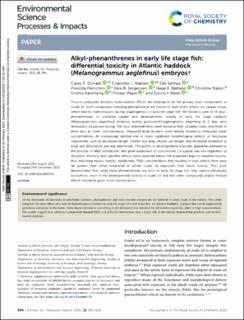Alkyl-phenanthrenes in early life stage fish: differential toxicity in Atlantic haddock (Melanogrammus aeglefinus) embryos
Donald, Carey; Nakken, Charlotte L.; Sørhus, Elin; Perrichon, Prescilla; Jørgensen, Kåre Bredeli; Bjelland, Hege Kristoffersen; Stølen, Christine; Kancherla, Sindhu; Mayer, Philipp; Meier, Sonnich
Peer reviewed, Journal article
Published version
Permanent lenke
https://hdl.handle.net/11250/3103142Utgivelsesdato
2023Metadata
Vis full innførselSamlinger
Originalversjon
Donald, C. E., Nakken, C. L., Sørhus, E., Perrichon, P., Jørgensen, K. B., Bjelland, H. K., ... & Meier, S. (2023). Alkyl-phenanthrenes in early life stage fish: differential toxicity in Atlantic haddock (Melanogrammus aeglefinus) embryos. Environmental Science: Processes & Impacts, 25(3), 594-608. 10.1039/d2em00357kSammendrag
Tricyclic polycyclic aromatic hydrocarbons (PAHs) are believed to be the primary toxic components of crude oil. Such compounds including phenanthrene are known to have direct effects on cardiac tissue, which lead to malformations during organogenesis in early life stage fish. We tested a suite of 13 alkyl- phenanthrenes to compare uptake and developmental toxicity in early life stage haddock (Melanogrammus aeglefinus) embryos during gastrulation/organogenesis beginning at 2 days post fertilization via passive dosing. The alkyl-phenanthrenes were tested at their solubility limits, and three of them also at lower concentrations. Measured body burdens were linearly related to measured water concentrations. All compounds elicited one or more significant morphological defects or functional impairment, such as decreased length, smaller eye area, shorter jaw length, and increased incidence of body axis deformities and eye deformities. The profile of developmental toxicities appeared unrelated to the position of alkyl substitution, and gene expression of cytochrome 1 a (cyp1a) was low regardless of alkylation. Mortality and sublethal effects were observed below the expected range for baseline toxicity, thus indicating excess toxicity. Additionally, PAH concentrations that resulted in toxic effects here were far greater than when measured in whole crude oil exposures that cause toxicity. This work demonstrates that, while these phenanthrenes are toxic to early life stage fish, they cannot individually account for most of the developmental toxicity of crude oil, and that other compounds and/or mixture effects should be given more consideration.

